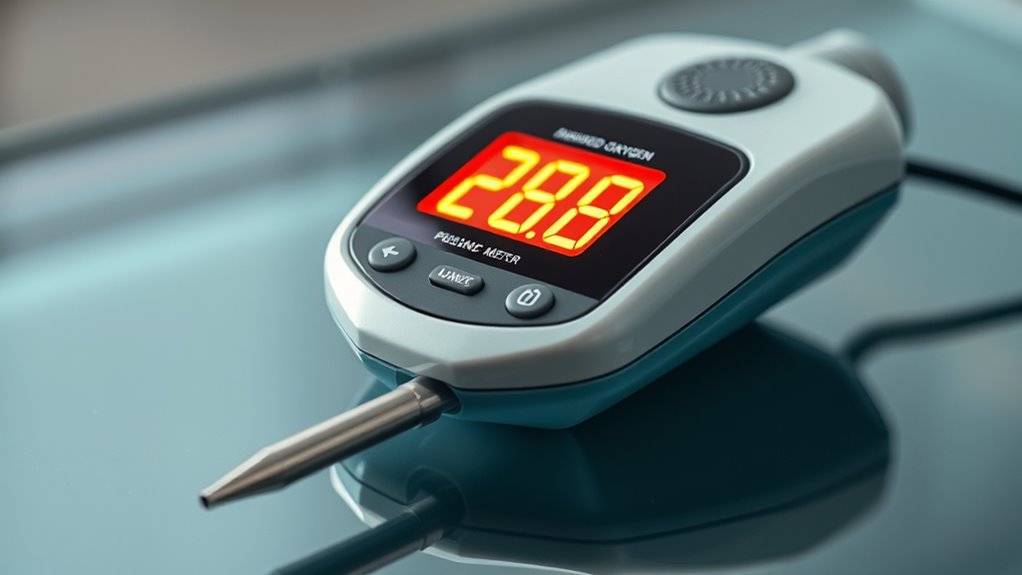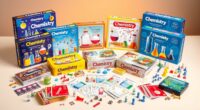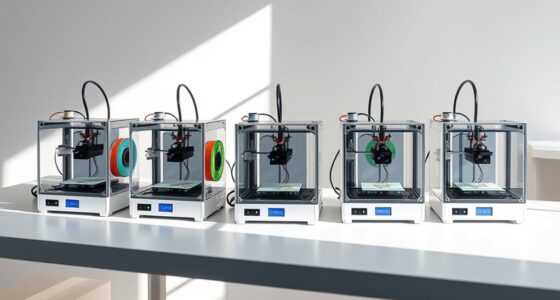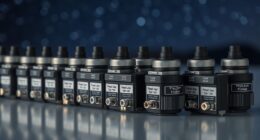If you’re looking for the 12 best dissolved oxygen meters for water analysis, I recommend models that combine accuracy, durability, and ease of use. Many feature automatic calibration, temperature compensation, and waterproof designs suited for field conditions. Devices like the Apera Instruments SX716 and YSI DO200 stand out for their reliability. Choosing the right one depends on your specific needs and environment. Keep reading to discover detailed options and key considerations for selecting the best equipment.
Key Takeaways
- Look for meters with a wide measurement range (up to 20 or 40 mg/L) for versatile water analysis.
- Choose devices with high accuracy (±0.1–0.3 mg/L) to ensure reliable dissolved oxygen readings.
- Prioritize models with automatic calibration and self-check features for consistent accuracy.
- Select waterproof, rugged designs with corrosion-resistant sensors suitable for field use.
- Opt for user-friendly interfaces with clear displays and minimal maintenance requirements to facilitate precise measurements.
Sper Scientific Portable Optical Dissolved Oxygen Meter (860067)
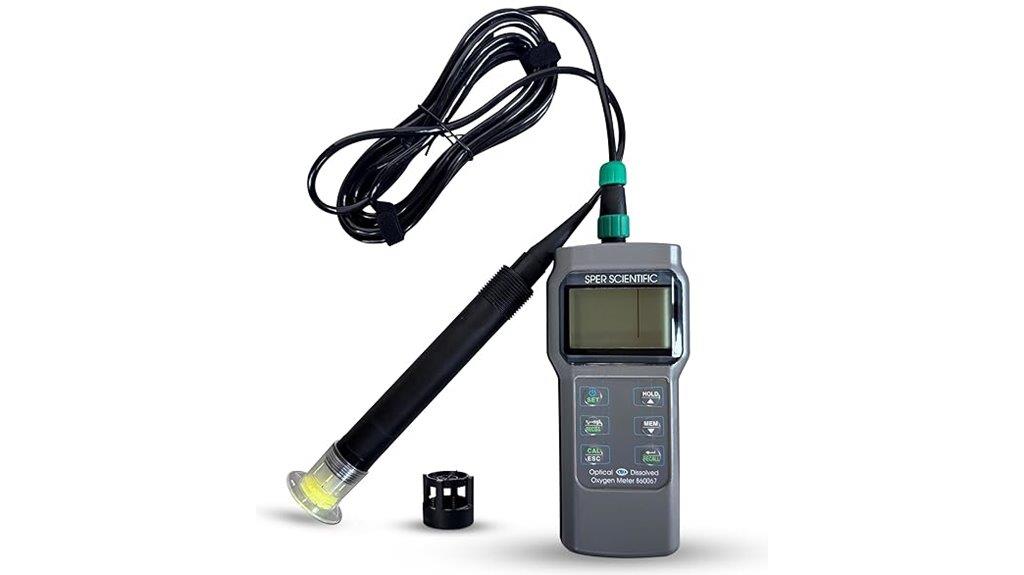
The Sper Scientific Portable Optical Dissolved Oxygen Meter (860067) is an excellent choice for professionals who need accurate and reliable water quality measurements in the field. It offers precise readings from 0.0–200.0% or 0.0–20.0 mg/L, unaffected by acid gases, making it ideal for aquaculture, environmental monitoring, and wastewater treatment. Its large LCD display shows DO levels and temperature simultaneously, ensuring clear visibility. With automatic temperature compensation and manual salinity and pressure adjustments, it guarantees accurate results. The low-maintenance design requires no probe upkeep, and the complete kit includes everything needed for field use—making it a versatile, hassle-free tool.
Best For: professionals in aquaculture, environmental monitoring, and wastewater treatment seeking accurate, reliable, and hassle-free dissolved oxygen measurements in the field.
Pros:
- Provides precise DO readings from 0.0–200.0% or 0.0–20.0 mg/L, unaffected by acid gases
- Large LCD display shows both DO levels and temperature clearly for easy readings
- Low-maintenance design with automatic temperature compensation and manual adjustments
Cons:
- Requires 6 AAA batteries, which need periodic replacement
- Limited to portable, field-based use; not suitable for laboratory settings
- May be more expensive than simpler dissolved oxygen meters due to advanced features
Apera Instruments SX716 Portable Lab Dissolved Oxygen DO Meter
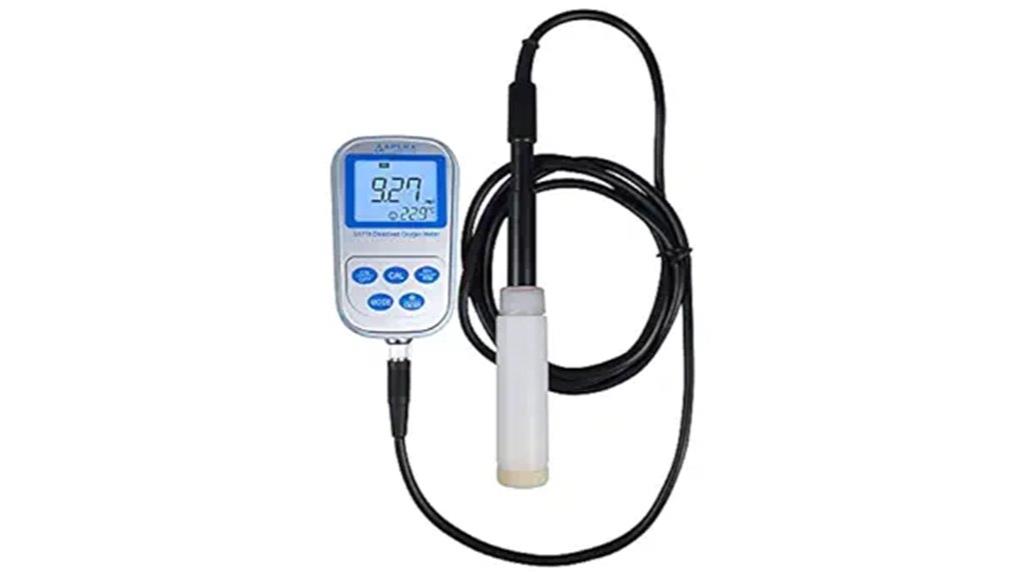
If you’re looking for a reliable and user-friendly dissolved oxygen meter for field water testing, the Apera Instruments SX716 stands out as an excellent choice. It features a durable, waterproof design with an IP57 rating, making it ideal for outdoor use. The device automatically calibrates for saturation and zero oxygen levels and compensates for temperature and salinity, ensuring accurate readings in various conditions. Its intuitive interface and quick setup—around a minute—make it accessible for both professionals and amateurs. Plus, with data logging for up to 100 measurements and additional water quality parameters, it offers versatility and convenience in a portable package.
Best For: professionals and hobbyists needing a reliable, portable dissolved oxygen meter for field water testing in diverse environments.
Pros:
- Easy to calibrate and operate with automatic temperature, salinity, and oxygen calibration features
- Durable waterproof IP57 rated design suitable for outdoor and harsh conditions
- Multifunctionality with additional water quality measurements like pH, TDS, and salinity
Cons:
- Small display can be difficult to read for some users
- Instructions may be unclear or require additional resources for full understanding
- Slightly higher price point compared to basic DO meters, but offers more features
Dissolved Oxygen Meter with ATC (0-40 mg/L Range)
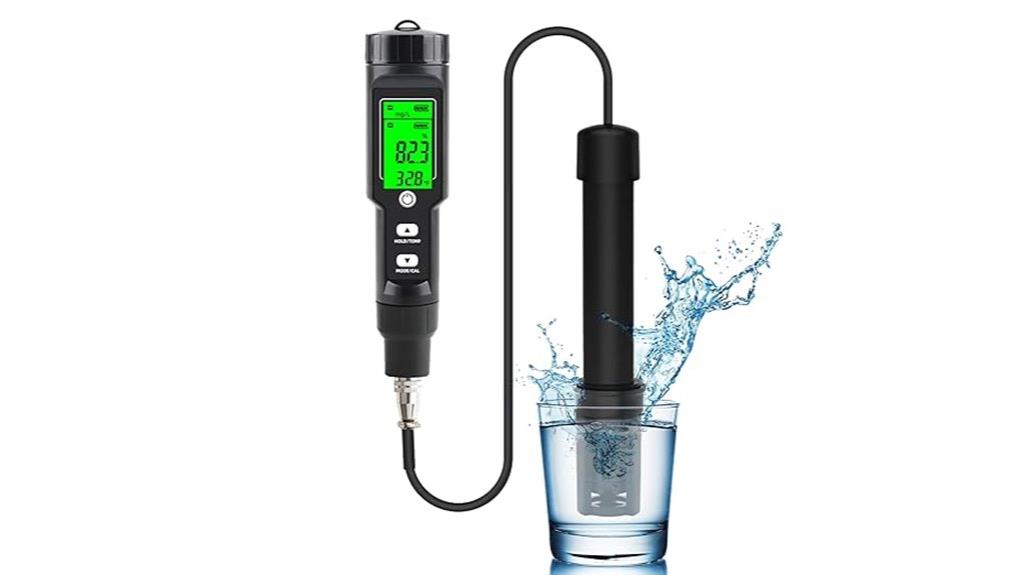
A Dissolved Oxygen Meter with ATC covering a 0-40 mg/L range is ideal for professionals and hobbyists who need quick, accurate water quality assessments across various environments. It features a built-in temperature sensor, high-precision electrodes, and a clear digital backlit display for easy readings. The device allows calibration without opening the electrode cover, ensuring hassle-free maintenance. Its temperature compensation maintains accuracy despite environmental changes, making it reliable in aquariums, ponds, and wastewater treatment. With fast response times and user-friendly operation, this meter offers a dependable tool to monitor and maintain healthy aquatic environments efficiently.
Best For: hobbyists, aquarium enthusiasts, and water quality professionals needing quick, accurate dissolved oxygen measurements in various aquatic environments.
Pros:
- Easy calibration without opening the electrode cover for hassle-free maintenance
- Built-in temperature sensor ensures accurate readings across environmental conditions
- Clear digital backlit display provides quick and easy interpretation of results
Cons:
- Limited to a measurement range of 0-40 mg/L, which may not suit extremely high oxygen levels
- Requires careful handling of electrodes and filling fluid to maintain accuracy
- Auto power-off feature after 8 minutes could interrupt testing if not managed properly
Digital Dissolved Oxygen Meter with Electrode for Aquaculture and Water Testing
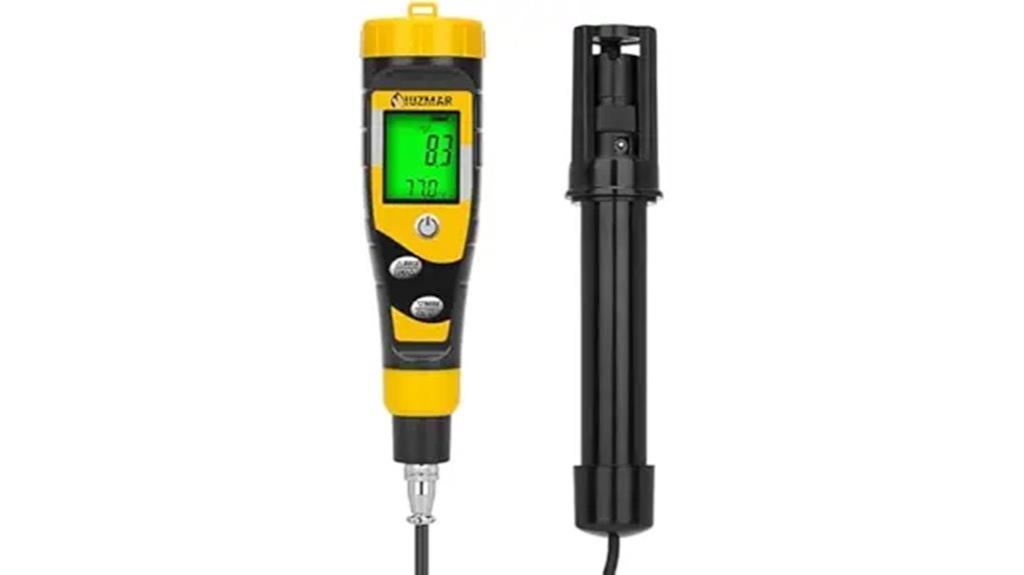
For aquaculture professionals and water testers seeking reliable, portable measurements, the UIUZMAR Digital Dissolved Oxygen Meter offers an excellent solution. It features a clear LCD display, a durable polarographic probe with a 3.6-foot cable, and measures dissolved oxygen, oxygen saturation, and temperature accurately. The device uses high-precision gold and silver electrodes, ensuring consistent results when properly calibrated. It’s suitable for ponds, aquariums, and water testing environments. While calibration can be tricky and the short cable limits water access, its rugged build, all-inclusive accessories, and straightforward operation make it a dependable choice for field measurements.
Best For: aquaculture professionals, water testers, and hobbyists needing portable, accurate dissolved oxygen measurements in various water environments.
Pros:
- Clear LCD display for easy reading of measurements
- Durable, protective probe shroud and high-quality electrodes ensure consistent performance
- Comprehensive accessories including membrane caps, electrolyte solutions, and calibration tools
Cons:
- Short 3.6-foot cable limits water access to within that distance from the device
- Calibration process can be confusing and may impact measurement accuracy if not performed correctly
- Lacks a rugged field case for improved durability during outdoor or rough handling situations
Monitor DISSOLVED Oxygen Test KIT (50 Tests)
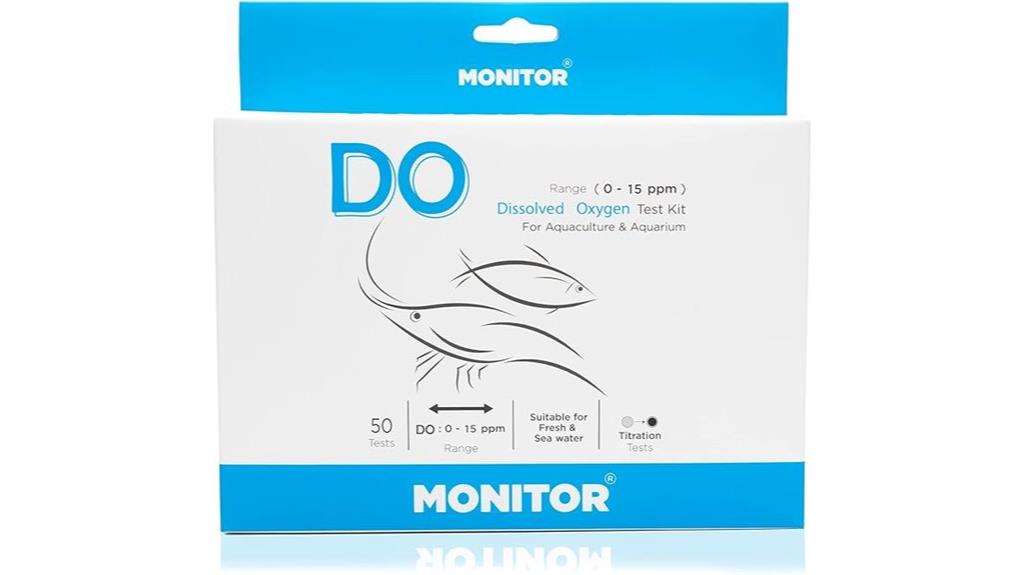
The Monitor Dissolved Oxygen Test Kit (50 Tests) stands out as an excellent choice for both hobbyists and professionals who need reliable, quick, and affordable water quality assessments. It measures dissolved oxygen levels from 0 to 15 ppm with 0.5 ppm resolution, essential for maintaining aquatic health in aquariums, ponds, and water sources. Using the modified Winkler titration method, it provides accurate results easily and efficiently. The kit includes enough reagents for 50 tests, making it cost-effective for routine monitoring. Its straightforward instructions ensure minimal difficulty, and users value its reliability and precision for diagnosing issues like low oxygen levels.
Best For: hobbyists, aquarium enthusiasts, and water quality professionals seeking reliable and affordable dissolved oxygen testing.
Pros:
- Easy to use with straightforward instructions for quick testing
- Provides accurate and consistent results using the modified Winkler titration method
- Cost-effective with enough reagents for 50 tests, suitable for routine monitoring
Cons:
- Reagent leakage may occur if not handled carefully
- Some users initially find the testing process slightly complex without proper guidance
- Requires careful storage of reagents to maintain accuracy over time
Dissolved Oxygen Test Kit for Water Testing

If you need a quick, reliable way to measure dissolved oxygen levels across various water sources, the Dissolved Oxygen Test Kit is an excellent choice. It’s versatile, suitable for freshwater, saltwater aquariums, ponds, sewage, and industrial water, supporting real-time testing in multiple environments. The kit allows up to 120 tests with results in just 3-5 minutes. It’s simple to use—just mix samples with reagents and compare colors. Complete with all necessary components in a portable case, it offers an economical solution for water quality monitoring, whether for casual testing, education, or professional applications.
Best For: casual water testers, educators, and professionals needing quick, reliable dissolved oxygen measurements across various water sources.
Pros:
- Supports up to 120 tests with rapid results in 3-5 minutes.
- Versatile for use in freshwater, saltwater, ponds, sewage, and industrial water.
- Complete, portable kit with all necessary components for easy and convenient testing.
Cons:
- Color readings can be similar across different oxygen levels, making precise detection difficult.
- Reagents may be messy if not handled carefully, and instructions sometimes lack detail on sample volume.
- Chemicals are unlabeled and caustic, requiring careful handling and safety precautions.
Milwaukee MW600 Portable Dissolved Oxygen Meter
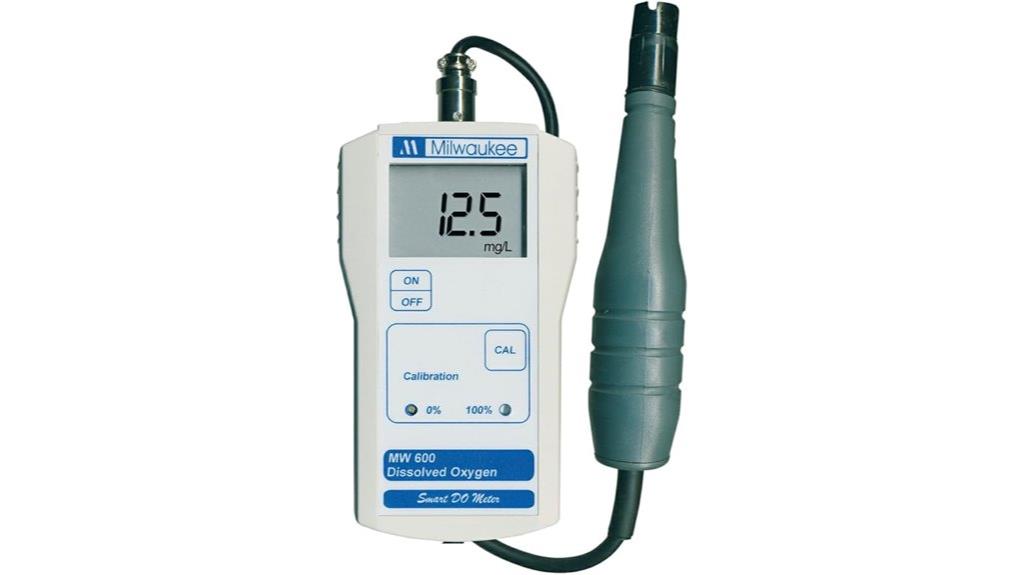
The Milwaukee MW600 Portable Dissolved Oxygen Meter stands out as an excellent choice for educational institutions, hobbyists, and small-scale water analysis tasks due to its straightforward operation and reliable accuracy. It features two-point manual calibration, automatic temperature compensation from 0 to 30°C, and a clear LCD display. The polarographic probe with a 3-meter cable ensures flexible testing, and the device’s simple design makes calibration quick and easy. With a measurement range of 0.0-19.0 mg/L and up to 7 years of probe lifespan, it offers good value. While some durability concerns exist, proper care guarantees consistent, accurate readings for water quality assessments.
Best For: educational institutions, hobbyists, and small-scale water quality testers seeking a reliable, easy-to-use dissolved oxygen meter.
Pros:
- Simple, straightforward operation with quick calibration
- Reliable accuracy with two-point manual calibration and automatic temperature compensation
- Long probe lifespan of up to 7 years with proper care
Cons:
- Variable durability; some users report probes wearing out or failing prematurely
- Cap and sensor handling can be tricky, risking damage if not handled carefully
- Additional accessories like sample bottles are needed for immediate testing, which are not included in the package
Dissolved Oxygen Meter with ATC, Portable Water Test Kit
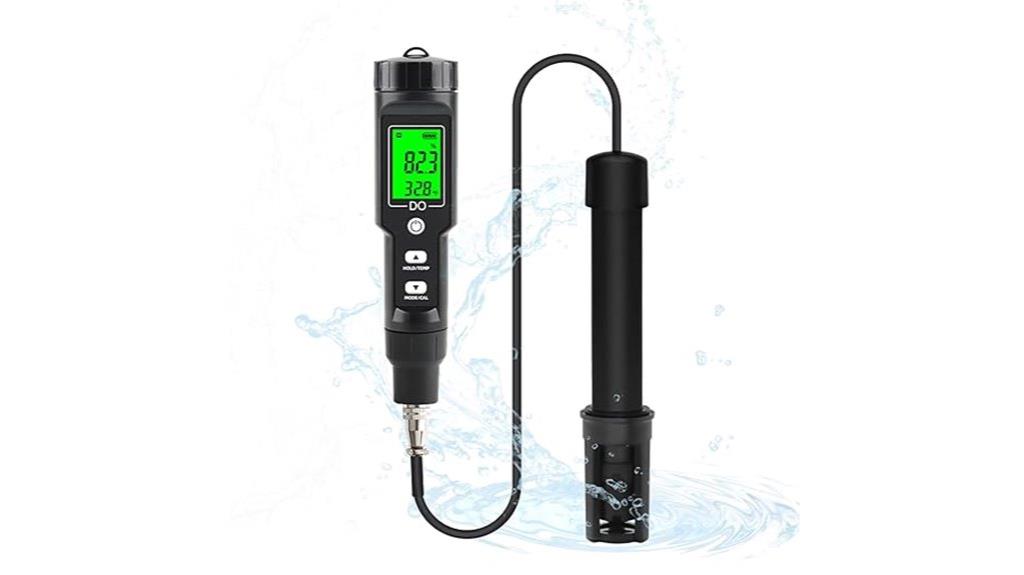
A portable dissolved oxygen meter with ATC and a water test kit is an excellent choice for professionals and hobbyists who need quick, accurate water quality measurements in various environments. It offers a range of 0.0-40 mg/L and includes electrode filling fluid, making it suitable for pools, aquariums, and ponds. Its digital backlit display ensures easy reading, even in low light, while automatic temperature compensation guarantees precise results. With features like automatic shutdown and low battery alerts, it’s user-friendly. This device helps monitor oxygen levels critical for aquatic life, environmental health, and scientific research, providing reliable data anytime, anywhere.
Best For: hobbyists, environmental professionals, and aquaculture farmers needing quick, accurate water quality testing in various settings.
Pros:
- Portable and easy to operate, suitable for on-the-go testing
- Digital backlit display ensures clear readings in all light conditions
- Automatic temperature compensation enhances measurement accuracy
Cons:
- Limited measurement range up to 40 mg/L, may not suit extreme water conditions
- Requires electrode filling fluid and rechargeable batteries, adding to maintenance
- May require calibration for precise long-term use
Smart Dissolved Oxygen Meter for Aquarium and Water Testing
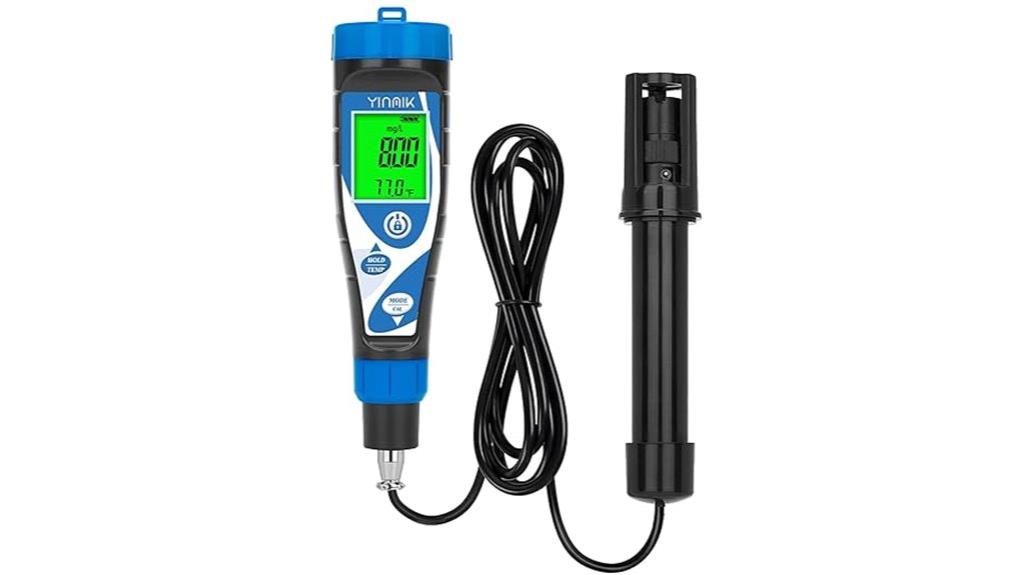
For aquarium and water testing enthusiasts seeking precise, real-time data, the Smart Dissolved Oxygen Meter by YINMIK stands out with its Bluetooth connectivity and data logging capabilities. It’s compact and portable, perfect for both indoor and outdoor use, with a clear LCD backlight for easy readings in dim environments. The device supports quick 1-2 second measurements, with adjustable salinity and altitude inputs via the YINMIK app to guarantee accuracy. Its ability to store up to 1,000 data points helps track water quality trends. Overall, it’s a reliable tool for maintaining ideal oxygen levels, promoting aquatic health, and supporting water quality management.
Best For: aquarium enthusiasts, aquaculture professionals, and water quality testers seeking quick, accurate dissolved oxygen measurements both indoors and outdoors.
Pros:
- Portable and lightweight design with a long probe cable for outdoor testing.
- Supports Bluetooth data logging up to 1,000 points, enabling trend tracking.
- Fast measurement response time of 1-2 seconds with clear LCD display.
Cons:
- Does not include a dedicated hard carrying case, relying on the box for storage.
- Powered by non-rechargeable button cell batteries, requiring replacement.
- Data logging is optional and may not be necessary for all users.
Apera Instruments AI480 DO850 Optical Dissolved Oxygen Meter Kit
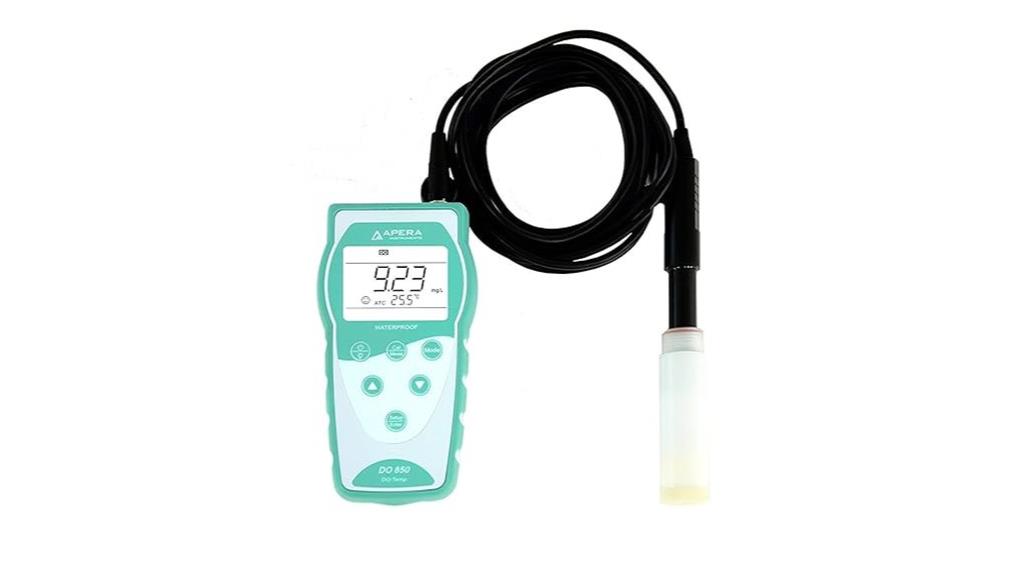
If you’re seeking a durable and reliable optical dissolved oxygen meter suitable for both field and laboratory use, the Apera Instruments AI480 DO850 stands out. It features an advanced optical sensor with a 10 ft probe, making measurements easy and accurate. The device offers stable readings with auto-lock and displays both dissolved oxygen and temperature on a large backlit LCD. Its rugged, waterproof, dustproof design ensures durability in harsh environments. Calibration is straightforward, with automatic adjustments for temperature, pressure, and salinity, providing precise results. Weighing just over 10 ounces, it’s user-friendly, long-lasting, and perfect for aquaculture, water testing, or fisheries.
Best For: aquaculture professionals, water quality testers, and environmental researchers seeking a durable, accurate, and easy-to-use dissolved oxygen meter for field and laboratory applications.
Pros:
- Reliable optical sensor with stable, quick readings and auto-lock feature
- Rugged, waterproof, and dustproof design suitable for harsh environments
- Easy calibration with automatic temperature, pressure, and manual salinity compensation
Cons:
- Slightly limited cord length for testing deeper water columns (recommend longer cables)
- No mention of Bluetooth or wireless data transfer capabilities
- Requires three AA batteries, which may need frequent replacement during extended field use
YSI DO200 Kit EcoSense DO 200 Dissolved Oxygen Meter Kit
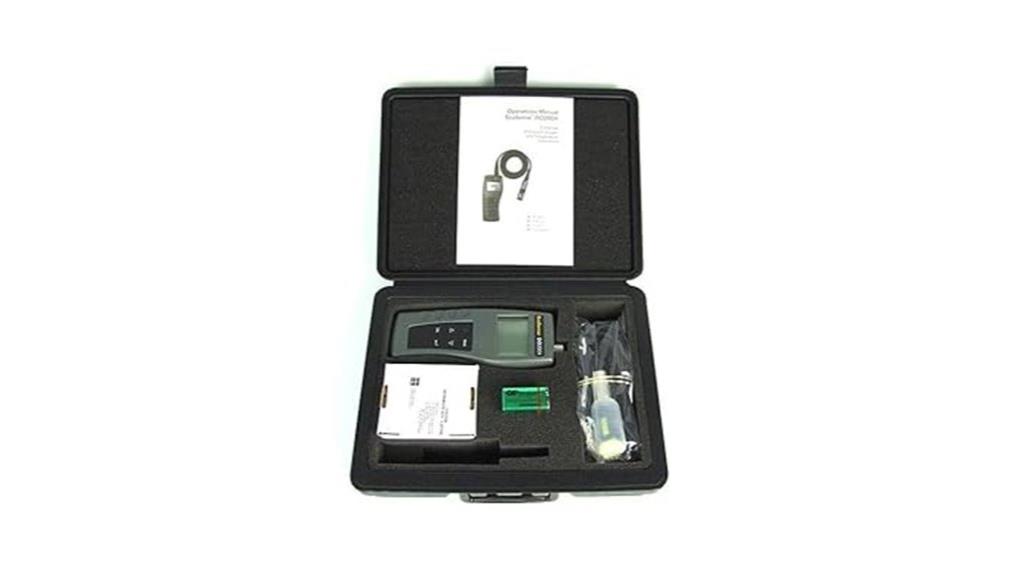
The YSI DO200 Kit EcoSense DO 200 Dissolved Oxygen Meter Kit is an excellent choice for field professionals who need accurate, reliable dissolved oxygen measurements on the go. It delivers 2% FS accuracy and offers a resolution of 0.01 ppm, ensuring precise readings in the field. The device features automatic temperature compensation and manual inputs for salinity and barometric pressure, enhancing measurement accuracy. Its portable design includes easy-to-replace screw-on cap membranes and a 9V battery, making it convenient for outdoor use. Overall, this kit combines ease of use with dependable performance, making it a top choice for water quality analysis.
Best For: field professionals and environmental researchers seeking portable, accurate dissolved oxygen measurements in outdoor water quality assessments.
Pros:
- Delivers high accuracy with 2% FS precision for reliable results.
- Features automatic temperature compensation and manual input options for salinity and barometric pressure, enhancing measurement accuracy.
- Portable and user-friendly design with easy-to-replace screw-on cap membranes and included 9V battery.
Cons:
- The resolution of 0.01 ppm may be insufficient for extremely precise laboratory measurements.
- Product details inside the case may vary, potentially affecting user expectations.
- Requires manual input for some parameters, which may introduce user error if not entered correctly.
2024 All-New 4-in-1 TDS Meter for Water Testing
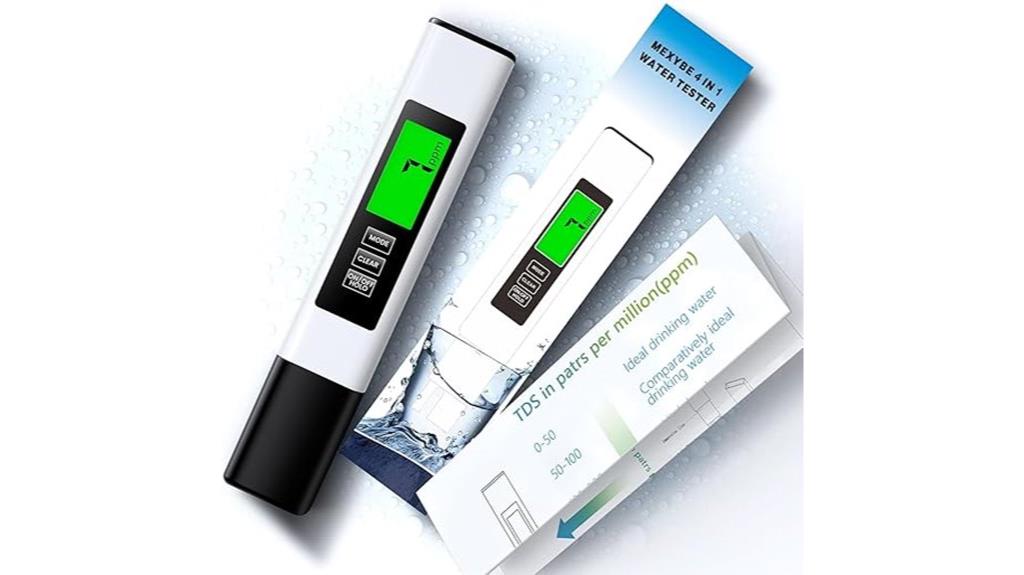
The 2024 All-New 4-in-1 TDS Meter for Water Testing stands out as an essential tool for homeowners, aquarium enthusiasts, and outdoor adventurers who need quick, accurate water analysis. Manufactured by MEXYBE, it measures TDS, EC, and temperature, providing extensive water quality info in seconds. Its large backlit LCD makes readings easy to see, while the titanium alloy probe ensures durability and precision. Designed for simplicity, it’s compact and lightweight, perfect for testing tap water, pools, aquariums, or filtered water. Users trust its reliability, valuing fast results and user-friendly features. This versatile device helps maintain safe, healthy water in any environment.
Best For: homeowners, aquarium enthusiasts, and outdoor adventurers seeking quick, accurate water testing for safe, clean water.
Pros:
- Provides rapid, reliable measurements of TDS, EC, and temperature in seconds.
- Features a large backlit LCD for easy reading in any lighting condition.
- Durable titanium alloy probe ensures long-lasting accuracy and durability.
Cons:
- Requires two LR44 batteries, which are sold separately.
- Minor discrepancies (10-40ppm) can occur in TDS readings depending on water source.
- May be less suitable for professional laboratory analysis due to its consumer-grade design.
Factors to Consider When Choosing Dissolved Oxygen Meters for Water Analysis
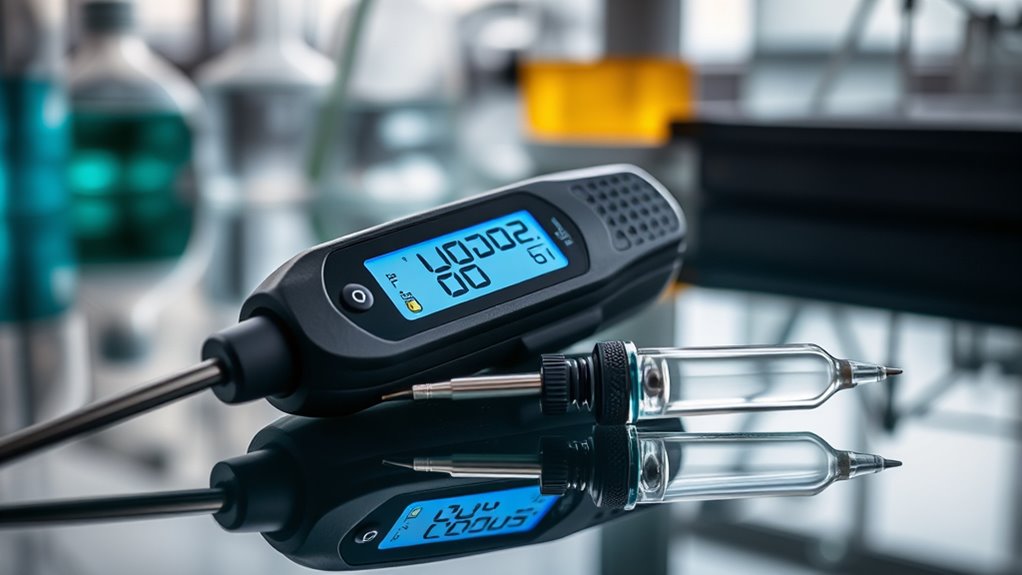
When choosing a dissolved oxygen meter, I focus on key factors like measurement range, accuracy, and how easy it is to calibrate. I also consider features that make the device simple to operate, as well as its durability and waterproofing for outdoor use. Finally, ensuring the meter’s compatibility with other water quality parameters helps me select the best tool for reliable analysis.
Measurement Range and Accuracy
Choosing a dissolved oxygen meter with an appropriate measurement range is vital for accurate water analysis. You want a device that covers typical oxygen levels in your water environment, like 0.0–20.0 mg/L for most aquatic settings. High accuracy is also essential; look for meters with ±0.1–0.3 mg/L precision or a small percentage of the reading to ensure reliable results. Confirm that the meter offers automatic or manual calibration options to maintain consistency over time. Temperature compensation features are important, as temperature fluctuations can skew readings. Additionally, consider the device’s resolution—finer resolutions, such as 0.01 mg/L, allow for more detailed water quality assessments. Together, these factors help you select a meter that provides precise, dependable measurements.
Calibration Ease and Frequency
Ensuring easy calibration is essential for maintaining accurate dissolved oxygen measurements, especially during routine water testing. Simple procedures like two-point calibration at zero and saturation points save time and minimize user error. Many modern meters feature automatic calibration or built-in solutions, providing more consistent results with less manual effort. However, electrochemical sensors often require more frequent calibration due to electrode polarization and membrane degradation, which can affect accuracy over time. Calibration frequency depends on usage conditions; harsher environments or after cleaning demand more frequent calibration. Reliable meters also include calibration reminders or record-keeping functions, helping guarantee ongoing accuracy and compliance with testing standards. Selecting a device with straightforward calibration features simplifies maintenance and guarantees trustworthy measurements over the long term.
Ease of Use Features
Ease of use is a crucial factor when selecting a dissolved oxygen meter, as it directly impacts measurement efficiency and accuracy. I look for models with large, backlit LCD screens that display readings clearly in various lighting conditions, making it easier to read results quickly. Devices with automatic calibration and simple setup save time and reduce errors, which is essential for reliable data. Instruments that include automatic temperature compensation and manual adjustments for salinity or pressure help ensure measurements are accurate across different water environments. I also prefer meters with single-button operation or minimal calibration steps, so even those new to water testing can use them confidently. Clear instructions and intuitive interfaces make the process straightforward, allowing for precise results without needing extensive technical knowledge.
Durability and Waterproofing
A dissolved oxygen meter must withstand tough field conditions, so durability and waterproofing are essential factors to consider. Look for a robust housing made from impact-resistant, corrosion-proof materials like high-grade plastics or stainless steel, which can endure rough handling and environmental exposure. Waterproof or water-resistant ratings such as IP67 or IP68 are crucial, ensuring the device functions reliably in wet or submerged conditions without water damage. The sensor and probe should be made from corrosion-resistant materials like gold or titanium to maintain accuracy in various water chemistries and extend lifespan. Proper sealing and gasket design are vital to prevent moisture intrusion into electronic parts. Additionally, devices with accessible maintenance and calibration features help sustain durability and accuracy over time.
Parameter Compatibility
Choosing the right dissolved oxygen meter depends heavily on its parameter compatibility with your specific water sources. First, check that the measurement range matches your water’s oxygen levels—0-40 mg/L for aquaculture or 0-20 mg/L for environmental monitoring. Confirm the device supports compensation for factors like temperature, salinity, and pressure, which influence readings. Some meters measure multiple parameters such as pH, salinity, and temperature simultaneously, providing a more thorough water analysis. Verify the sensor type—optical or electrochemical—fits your needs for accuracy, maintenance, and durability. Finally, verify that calibration features and adjustment options align with your routine testing requirements. Proper parameter compatibility ensures reliable, precise measurements essential for water quality management.
Portability and Field Use
When selecting a dissolved oxygen meter for field use, portability becomes a top priority, as it directly impacts your ability to perform accurate water testing in remote or challenging environments. A lightweight, compact design makes carrying the device easier, especially during long sampling trips. A durable, waterproof or water-resistant casing protects the meter from rain, splashes, and dust, ensuring reliable operation outdoors. Long, flexible probes or extended cables allow measurements in deep or hard-to-reach water without needing to move the entire device. Battery life is also critical; rechargeable or replaceable batteries ensure you can operate the meter for extended periods without access to power. Additionally, user-friendly interfaces and quick calibration features help streamline testing, saving time and reducing errors during field analysis.
Cost and Maintenance
Considering the costs associated with dissolved oxygen meters is crucial for making a wise investment. I look at both the initial purchase price and ongoing expenses like calibration solutions, replacement electrodes, and maintenance parts. Optical meters often cost more upfront but require less maintenance and calibration, saving money over time. Devices with automatic calibration or self-cleaning features reduce labor and servicing costs, making them more economical for frequent use. It’s also important to evaluate the availability and price of replacement electrodes and calibration materials since high costs or limited supply can markedly increase overall ownership expenses. Balancing upfront affordability with long-term operational costs helps ensure you choose a meter that’s cost-effective and reliable for your water analysis needs.
Frequently Asked Questions
How Do Optical and Electrochemical Dissolved Oxygen Meters Compare?
When comparing optical and electrochemical dissolved oxygen meters, I find optical sensors offer advantages like quicker response times, less maintenance, and no need for consumables. Electrochemical meters are often more affordable initially but require regular calibration and electrolyte replacement. I prefer optical meters for their durability and accuracy over time, especially in demanding environments. Both types work well, but your choice depends on your specific needs and budget.
What Maintenance Is Required for Dissolved Oxygen Meters?
Did you know proper maintenance can extend a dissolved oxygen meter’s life by up to 50%? I regularly calibrate my device according to the manufacturer’s instructions, clean the probe with gentle solutions, and store it properly when not in use. Replacing membranes and electrodes periodically also guarantees accurate readings. Staying diligent with these steps saves money and guarantees reliable water quality data over time.
Can Dissolved Oxygen Meters Measure Other Water Parameters?
Dissolved oxygen meters primarily measure oxygen levels in water, but some models can also assess other parameters like pH, temperature, and conductivity. I’ve found that multi-parameter meters are handy, especially for all-encompassing water analysis. However, if you need precise readings of specific parameters, it’s best to use dedicated instruments. Always check your device’s specifications to see which additional water quality factors it can accurately measure.
How Does Water Temperature Affect Dissolved Oxygen Readings?
Water temperature critically impacts dissolved oxygen readings because warmer water holds less oxygen, while cooler water holds more. When I measure DO levels, I always consider temperature, as it affects the accuracy of my results. Many meters have temperature compensation features, which adjust readings accordingly. So, I make sure to monitor temperature closely and use meters with built-in compensation to ensure my readings truly reflect the water’s oxygen content.
Are Portable DO Meters Suitable for Long-Term Water Monitoring?
Portable DO meters are great for short-term or spot testing, but I wouldn’t rely on them for long-term monitoring. They can be affected by calibration drift, battery life, and environmental conditions. For continuous, reliable data over time, I prefer fixed systems with data loggers, which provide consistent readings and minimize human error. If you need ongoing monitoring, investing in a more permanent setup is definitely the way to go.
Conclusion
Choosing the right dissolved oxygen meter feels a bit like selecting the perfect compass for a journey—each one guiding you toward clearer, more accurate water insights. By considering your specific needs and the features that matter most, you can navigate water testing with confidence. Remember, the right tool isn’t just about numbers; it’s about ensuring your water environment remains vibrant and healthy, like a well-tended garden thriving under the right sunlight.
